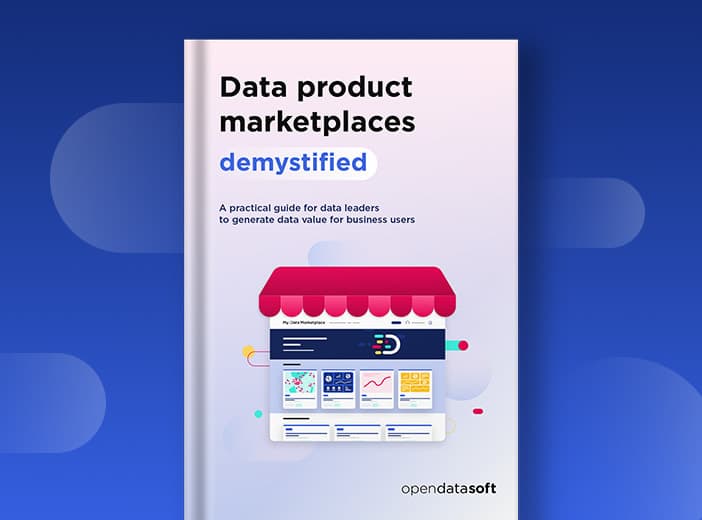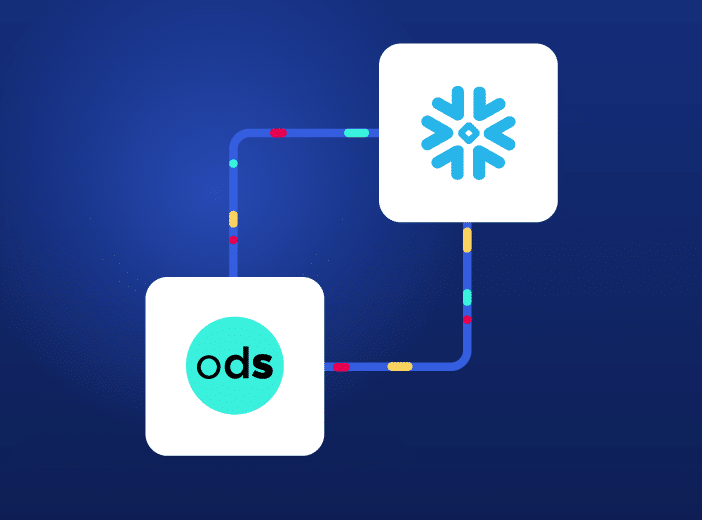What is a data product marketplace?
To meet their need to increase data consumption and maximize value, businesses are increasingly implementing centralized, self-service data product marketplaces. We look at what they are, and how they deliver value for employees, the business, data teams and data leaders.

Organizations are generating and collecting ever-growing volumes of data. To create meaningful value from this data and to increase productivity, innovation and collaboration, they need to make it available to be shared and consumed widely across the business.
Data leaders agree – 85% say that sharing data with all employees is critical to maximizing its value. However, this is currently not happening at scale within many organizations, with data siloed in systems and expert tools. These issues mean that it isn’t immediately available to business users, holding back data consumption and preventing organizations unlocking the full benefits of their data. Just 37% of data leaders believe that all their relevant data is accessible, according to research undertaken by Odoxa, for example.
How can businesses empower all of their employees with access to the right data, in the right format, in a seamless, understandable way? In this blog we’ll explain how a data product marketplace bridges the disconnect between data and users, maximizing consumption and value.
The need to enable data consumption at scale
Organizations have never had access to so much information, whether from business systems, sensors, partners or other sources. Yet, the sheer size and range of data sources, and the increasing speed in which data is being generated threatens to overwhelm them. In a complex data landscape, being able to understand and share information is difficult, with data stuck in silos or only accessible through technical tools that can solely be used by data experts.
Even if employees could access this raw data, much of it is difficult to immediately understand and use, lacking context and meaning. This leads to it simply not being seen as reliable or trustworthy. Essentially, it is not consumption ready.
The impacts of data silos
All of this damages the business in multiple ways:
- Data is not used widely, leading to missed opportunities and poor decision-making across the entire business
- Large amounts of time is wasted by employees searching for the right data or even duplicating existing information as they don’t know it already exists. Data teams are overwhelmed by requests from business users for information and reports, adding to their workloads and preventing them focusing on more strategic aims
- Existing spend on technology tools and data teams does not deliver an optimal ROI, as the business fails to see real value from data budgets
Everyone involved is frustrated – users cannot quickly get to the information they need to do their jobs, data teams spend their time on low-value responses to requests for data, and the Chief Data Officer (CDO) and other leaders find it difficult to justify their budgets and activities.
The importance of the data product marketplace
What is needed is a way of instantly connecting all users directly with the data they need, in the right form, building trust while ensuring security and data governance. Achieving this requires two interlinked concepts – data products and a data product marketplace.
What is a data product?
As we set out in this blog, a data product is a high-value data asset that has been created to meet a specific business need for a large number of users, and is governed through a data contract.
Data products include everything needed by a user to consume the underlying data. This might be through an interactive dashboard or app, or by integrating it into the tools they use in their daily working lives. Data products are continually monitored, updated, and improved, meeting an ongoing need in the business.
What is a data product marketplace?
Simply creating data products does not guarantee their consumption. They need to be easily discoverable, accessible, and usable – employees have to know that they exist and where they can find them. While data products can be shared over email, on an intranet/wiki or through technical data management solutions, this does not ensure that they can be easily accessed and consumed.
This is where a data product marketplace is vital. Just like an e-commerce marketplace, it showcases all of an organization’s data products and other data assets in a single, centralized space. It promotes data products through an intuitive, self-service interface that enables them to be easily found and confidently consumed by users. It must be scalable, to cope with increasing data volumes and user needs, secure to ensure compliance and good governance, user-centric to encourage adoption, and incorporate AI-driven innovation to maximize usage and efficiency.
A data product marketplace benefits data consumers, data product owners, and data governance teams:
- Data consumers can seamlessly find and access the information they need through an intuitive, self-service experience
- Data producers are able to easily publish data products and other data assets, engage with users, and act on their feedback to drive improvements
- Data governance teams can monitor data usage, ensure security and compliance, and pinpoint user needs for new data products
All of this means that organizations can democratize access to their data, maximize its use and therefore increase and scale the value that it delivers to the business.
The three pillars of the Opendatasoft data product marketplace
Opendatasoft’s data product marketplace is designed around three pillars that maximize usage and drive ROI:
- Built-in data governance through its integrated data catalog, business glossary, metadata management, data lineage and data quality tools
- Simplified administration through capabilities that allow personalization, integrated access rights management, in-built data visualization creation, automation, and analytics & monitoring tools
- Seamless user experience, with users able to discover and easily consume information through AI search, the availability and promotion of data products, straightforward data sharing & APIs, and tools for collaboration
The benefits of the data product marketplace
A data product marketplace can be internal (shared just with employees), ecosystem (sharing data with and between partners), or public (sharing data with all audiences). Whichever type of data product marketplace is adopted, it delivers clear benefits to all stakeholders:
Greater productivity
With immediate, self-service access to the data they need, users are able to work more productively, taking better-informed decisions and avoiding wasting time searching for information. Data team productivity also improves – rather than continually responding to requests for information from business users, they can focus on higher-value activities that maximize the use of their time.
Increased innovation
Making data available through data products spurs innovation within the organization and beyond. Data products can power new ways of working internally, while enabling emerging opportunities to be targeted faster, increasing agility. They can also be the engine for new data services that can be offered externally to customers and partners, creating new revenue streams that boost the bottom line.
Budget optimization
Organizations have invested heavily in their technology and data stacks. However, often this technical infrastructure doesn’t have an end product that justifies the investment, with data still not available to be consumed at scale. Data products delivered via a marketplace maximize data use, underpinning concrete reuses that provide a measurable business benefit and ROI.
Improved transparency
Many organizations, in both the public and private sector, have a regulatory requirement to share data with the public. For example, public bodies have to demonstrate their performance against KPIs and show how they are delivering value for their budgets. A public data product marketplace provides a single space to share data in easily consumable ways, not only ensuring compliance but improving engagement with all stakeholders.
The rise of the data product marketplace
Across all sectors, data leaders understand the need to democratize data consumption, making it easily available so that it can be found, accessed and used by every employee, without requiring support from data teams.
The combination of ready-to-consume, high-value data products, and intuitive, self-service data product marketplaces provide the only viable approach to delivering data consumption at scale. They free data from silos caused by expert tools, build confidence and trust in data and ensure strong governance and compliance. This generates faster, more measurable ROI, greater productivity, increased efficiency, and better-informed, data-driven decision making, helping businesses to thrive in increasingly complex and competitive markets.
Want to ensure your data is easily consumable at scale across your organization? Contact us to learn how Opendatasoft’s data product marketplace can maximize data value for your business.




